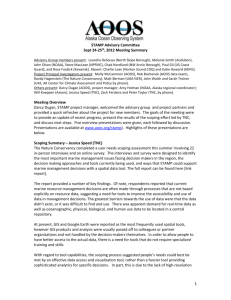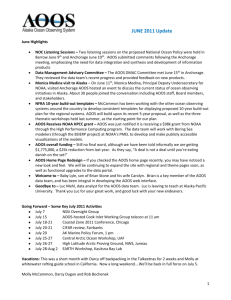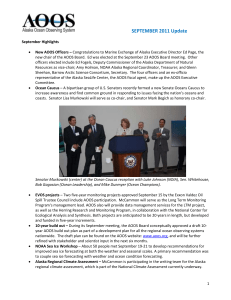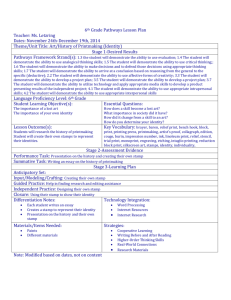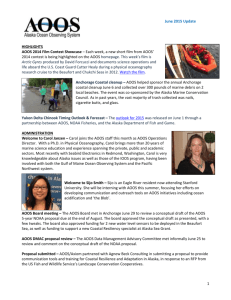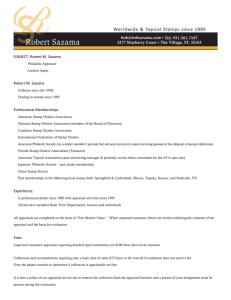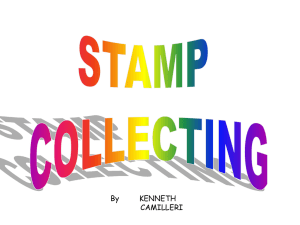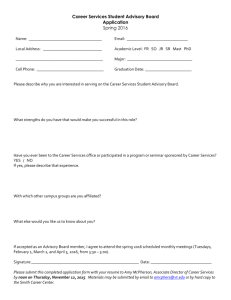STAMP April 6 summary - Alaska Ocean Observing System
advertisement
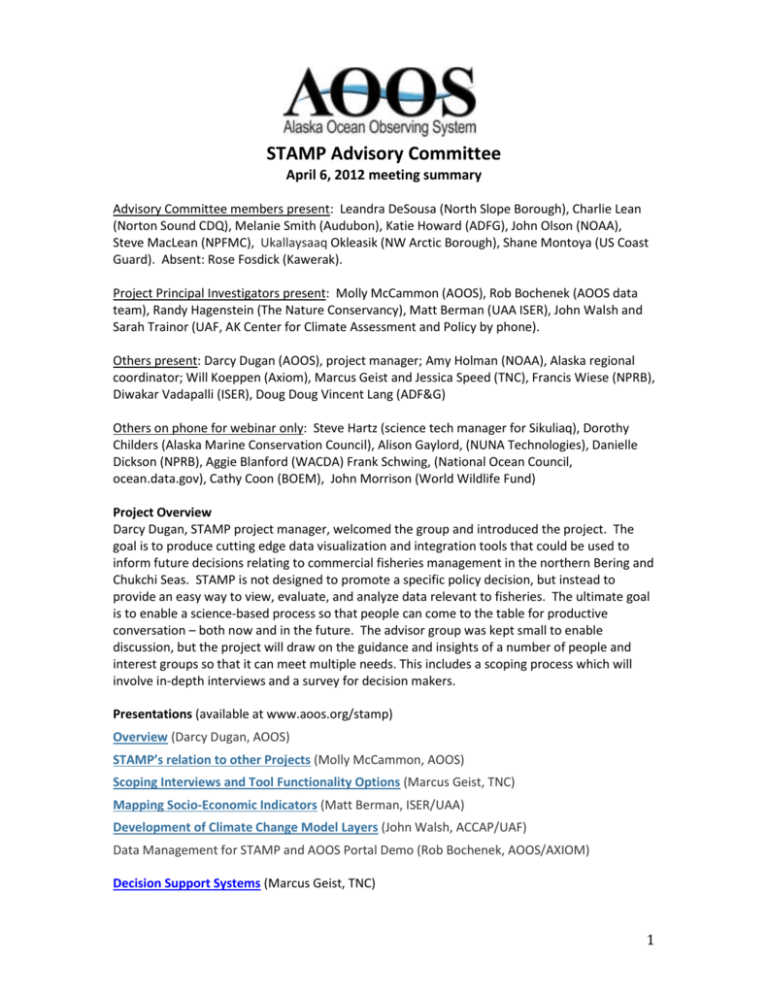
STAMP Advisory Committee April 6, 2012 meeting summary Advisory Committee members present: Leandra DeSousa (North Slope Borough), Charlie Lean (Norton Sound CDQ), Melanie Smith (Audubon), Katie Howard (ADFG), John Olson (NOAA), Steve MacLean (NPFMC), Ukallaysaaq Okleasik (NW Arctic Borough), Shane Montoya (US Coast Guard). Absent: Rose Fosdick (Kawerak). Project Principal Investigators present: Molly McCammon (AOOS), Rob Bochenek (AOOS data team), Randy Hagenstein (The Nature Conservancy), Matt Berman (UAA ISER), John Walsh and Sarah Trainor (UAF, AK Center for Climate Assessment and Policy by phone). Others present: Darcy Dugan (AOOS), project manager; Amy Holman (NOAA), Alaska regional coordinator; Will Koeppen (Axiom), Marcus Geist and Jessica Speed (TNC), Francis Wiese (NPRB), Diwakar Vadapalli (ISER), Doug Doug Vincent Lang (ADF&G) Others on phone for webinar only: Steve Hartz (science tech manager for Sikuliaq), Dorothy Childers (Alaska Marine Conservation Council), Alison Gaylord, (NUNA Technologies), Danielle Dickson (NPRB), Aggie Blanford (WACDA) Frank Schwing, (National Ocean Council, ocean.data.gov), Cathy Coon (BOEM), John Morrison (World Wildlife Fund) Project Overview Darcy Dugan, STAMP project manager, welcomed the group and introduced the project. The goal is to produce cutting edge data visualization and integration tools that could be used to inform future decisions relating to commercial fisheries management in the northern Bering and Chukchi Seas. STAMP is not designed to promote a specific policy decision, but instead to provide an easy way to view, evaluate, and analyze data relevant to fisheries. The ultimate goal is to enable a science-based process so that people can come to the table for productive conversation – both now and in the future. The advisor group was kept small to enable discussion, but the project will draw on the guidance and insights of a number of people and interest groups so that it can meet multiple needs. This includes a scoping process which will involve in-depth interviews and a survey for decision makers. Presentations (available at www.aoos.org/stamp) Overview (Darcy Dugan, AOOS) STAMP’s relation to other Projects (Molly McCammon, AOOS) Scoping Interviews and Tool Functionality Options (Marcus Geist, TNC) Mapping Socio-Economic Indicators (Matt Berman, ISER/UAA) Development of Climate Change Model Layers (John Walsh, ACCAP/UAF) Data Management for STAMP and AOOS Portal Demo (Rob Bochenek, AOOS/AXIOM) Decision Support Systems (Marcus Geist, TNC) 1 ‘Big Picture’ Discussion Points STAMP tools will not be designed simply to provide a “go/no go decision” relating to commercial fisheries. They will be designed to help integrate existing data, identify gaps, and help inform the big picture. The term ‘decision makers’ for this project is interpreted broadly. It includes everyone in the advisory group, whether they are community representatives, regulatory agencies, biologists, subsistence users, industry, conservation specialists… people that have input or opinions about planning, management or economic decisions. The NPFMC is developing a paper to describe the limited information available for the Northern Bering Sea, as well as gaps, in order to devise a research plan. When completed, this document could help inform development of the STAMP tools. There is not currently a push to expand fisheries into the northern Bering because it’s not currently commercially viable. However, what’s not viable for a large commercial fishery may be viable for a small boat, more nearshore fishery. “Economic viability” depends on perspective. There is a gap between nearshore research and open ocean research. Most funded research seems to be focused far from the coastal environment, excluding local fisheries (or at least that is the perception). Don’t leave out the nearshore. It will be important to use care with sensitive data – some data is easy to misinterpret, and summarizing data may be appropriate at times. Also, characterizing uncertainty of data will require careful thought. Local knowledge should feed into priorities for research/evaluation. Community partnership, communication, and transparency are key to big decisions such as expanding fisheries. Data Discussion Points STAMP datasets need to reflect historic, current, and future projections. The lack of fish data is a big issue. There are very few fish surveys in this region because there are few commercial fisheries - small crab and salmon in state waters. (Audubon did a comprehensive search for the Arctic Marine Atlas and only found information on 5 species. The Arctic FMP echoed the state of limited data.) Existing or new fisheries data needs to be compiled and visualized in a way that shows biomass over some area of interest, including hot spots and low spots, timing, biological information, and climatological oceanography. Check the ERMA data list – don’t duplicate their effort Note: Identified data needs can be found at the bottom of the document Points raised about potential tool functions There are many existing decision support tools available with various types of functions (pre-defined scenarios, trade-off analyses, user-developed analyses, data visualization). Whether one tool is better than another depends on who the users are. It’s easy to get lost on a web portal if data isn’t well described – datasets need metadata or summary information. One of the important functions of the STAMP tool may be to identify data gaps. 2 The capacity to add dimensions of time and depth to STAMP tools will be available if people would like them. Dealing with uncertainty will be tricky. We need to be conscious about how to incorporate caveats to do due diligence and promote correct use of the data. An intuitive interface is critical – start off with a map instead of large suite of options. People don’t want 1,000 data sets to sift through on their own. They need them set up in a way that makes sense to answer specific questions. Make a clear different between data with the value “zero” and places with no data. Include a way to incorporate hotspots if key biological areas are changing. The cultural value of species is different – some species may be more valuable than others (even if not commercially valuable). Some aspect of this differentiation could be incorporated into the tool. Note: the advisory group did not come to a conclusion on specific types of functionality the STAMP tools should have. This conversation will continue, and will also be informed by scoping interviews over the next few months. Potential processes/phenomenon the tool could help explain or display Species migration up the coast and its coincidence with the coastal current Combining sea ice dynamics with river break up and coastal current Bycatch of fish and marine mammals, seabirds, and subsistence and their potential impacts to the food web and local communities Data to help inform how fishery development would affect forage resources Yukon breakup timing and green-up of Shaktoolik hills (informs herring spawn timing estimates) Melting permafrost and how it effects river systems Allocation issues and displacement of existing practices Note: This list will continue to be developed, as advisory group had only very initial discussion on this topic. Next Steps The advisory group helped identify a lengthy list of people involved in natural resource decision making for the region. This list will be added to and refined after the meeting. TNC will then conduct interviews to better understand how these individuals currently make decisions, what tools or resources they use, and what additional tools they would find helpful. An online survey will be sent with similar questions to reach a broader audience than those who are able to be interviewed. AOOS will begin assimilating identified data into its Ocean Portal, using leads from the advisory group and others. The results of the advisory group meeting, interviews, and surveys will help guide the first iteration of tool development. Follow up conversations will be required before the tools are ready for beta testing. AOOS will then begin testing different types of tool functionality, and will solicit feedback from the advisory committee. 3 Initial Data Needs identified by the advisory group: o Fisheries surveys – specific species, location, timing, biomass (most of this data doesn’t exist) o Ice habitat; timing of ice melt, retreat of ice pack, location of ice edge, movement o Shore fast ice o Cumulative impacts – increased human usage - oil & gas, shipping, offshore mining o Cumulative impact layers from NCEAS study – Ben Halperin o Shipping - both community/local and industrial o Port development information – infrastructure, bathymetric data o Environmental effects of ports, & infrastructure, dredging, accretion, o Traditional knowledge, with respect to infrastructure siting o Coastal current temperature, salinity o Rivers, spawning habitat, and river drainages o Salinity in nearshore marine environment and during break up o Linkages between river breakup and ocean breakup o Sea floor type/characteristics o Nearshore habitat o Ocean conditions o Community characteristics o Data from ERMA o 20 years of subsistence use data from the NSB, also from Steve Braund o Subsistence data from NWAB mapping project o ADFG data from Lori Quackenbush o Inuvialiq – Canadian datasets o Pelagic surveys done by NMFS since 2002 o BOEM environmental studies – fisheries, ice seals, etc. o Archived mooring data o OCSEAP data (in digestible form) o GOAIERP type model (FEAST) – future fish scenarios o Animal telemetry data Note: This list is not comprehensive, but serves as a starting point. AOOS will be looking further into these categories and talking with contacts that are familiar with specific datasets. 4
